geology earthquakes lecture
1/112
There's no tags or description
Looks like no tags are added yet.
Name | Mastery | Learn | Test | Matching | Spaced |
|---|
No study sessions yet.
113 Terms
fault motion
how blocks move relative to each other accross a fractrue in the Earth’s crust
why is the term fault motion a bit misleading
because it isn’t the fault that’s moving, but rather the lithosphere on either side
what was something that happened in the lead up to the 1906 earthquake
fences/survey line/figures along the san andreas fault were beginning to bend
why did the fences bend?
elastic deformation of the underlying rocks
what happened to the fence after the 1906 earthquake
it separated by up to 7 meters (avg. offset was 11-15 ft)
elastic strain
(or deformation) the principle that as long as stress is applied, the object on which stress is applied will strain
what happens when stretch is removed in elastic strain
the object will snap back into its original position
elastic limit
point of elastic strain that an object reaches where the stress is too much, and strain that has been stored is released, typically resulting in the object breaking (or an earthquake!)
elastic rebound model
model for the generation of earthquakes that is in terms of elastic strain and stress (as defined earlier) and the principle that rocks act elastically
why is the common misconception about little earthquakes preventing a big one wrong
because it operates on the belief that little releases of pressure would prevent bigger ones, but earthquakes don’t have anything to do with “pressure", it’s about directed forces in the crust of the earth
continuous slip
a characteristic of fault creep, a slow, steady, and aseismic (non-earthquake) movement along a fault surface that lacks strain buildup
how does fault creep prevent earthquakes
it creeps slowly, and does not generate strain that requires sudden release which would result in an earthquake
what is the reality if many little earthquakes are occuring
they are more likely to be foreshocks and a harbinger of the big one rather than “little releases of energy” (which doesn’t exist!)
fault trace
the surface line where a geological fault intersects the Earth's surface (most often a visible crack)
aftershocks
smaller earthquakes that occur after a big earthquake; can last for days, weeks, months, years
why do aftershocks happen
since a lot of strain is released during an earthquake, the rocks in and around the area of rapture need to catch up to the slip to redistribute strain
what is being looked at when studying earthquakes
slip along the area of rupture along the plane of a fault
focus
the midpoint of an area of rupture; is in the middle of the propagation of seismic waves
epicenter
the place directly above the focus of an earthquake
fault
a break in the earth’s crust in which there’s been appreciable motion
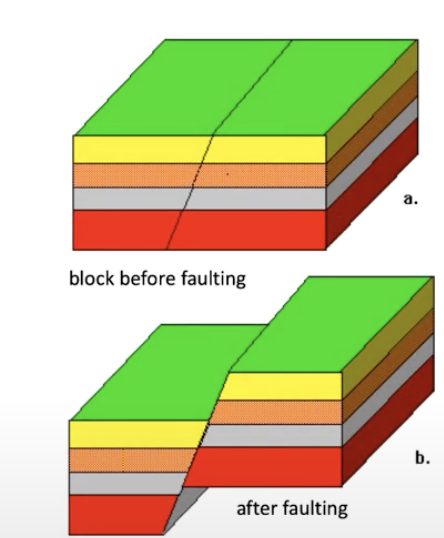
what kind of fault is this
dip-slip fault
geometry of a dip-slip fault
hanging wall moves down relative to the foot wall
crust of a dip-slip fault
becomes longer across the falt
what creates a normal fault on a large scale
the earth’s crust gradually moving apart
how does stress work in a normal fault
the crust of the earth has more pressure that is compressional, but this is less than the push inward by gravity and what results is a normal fault
the gravity and stress relationship in a normal fault
the dominant stress is vertical stress from gravity which means that the horizontal stresses are insufficient to prevent the rock from extending horizontally and sliding down
why crust extends in a normal fault
Because the fault plane is inclined, the downward vertical movement also creates a horizontal component of separation called heave. This heave results in a net increase in the horizontal length of the crust across the fault l
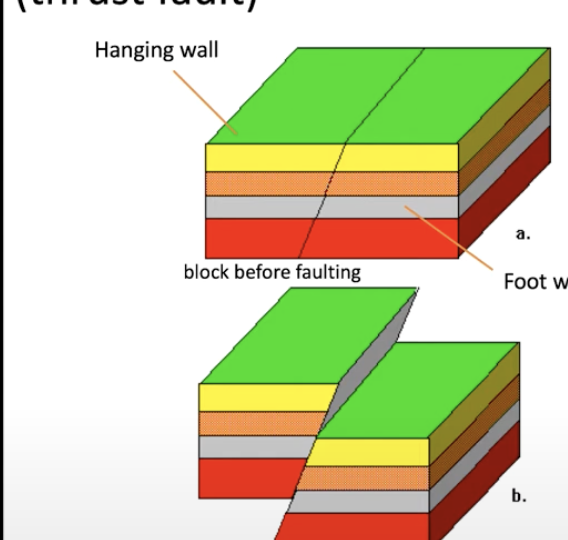
what kind of fault is this
reverse fault/thrust fault
reverse faults, historically
very steep faults
thrust faults, historically
low angle or more complex reverse faults
geometry of a reverse fault
hanging wall moves up relative to the foot wall
crust of a reverse fault
becomes shorter across the fault
thrust fault is a result of
horizontal compression
how compression works in a reverse fault
the major component of stress is coming in perpendicular to the fault — and outweighs the minimum principle stress
the gravity and stress relationship in a reverse fault
compression is the maximum principal stress and gravity is the minimal, which causes the reverse movement
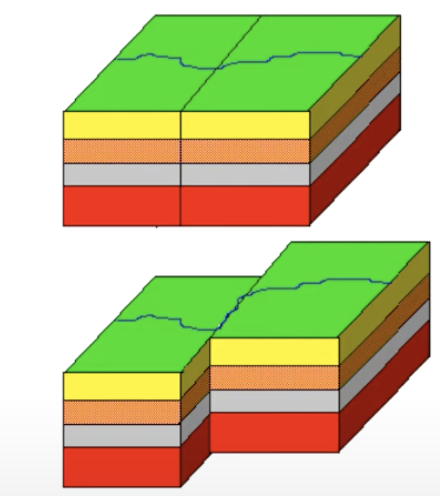
what type of fault is this
left-lateral strike-slip fault
geometry of a strike-slip fault
either left or right lateral slip
“looking across a fault”
always the fault further from where you stand. on either side, no matter which you’re standing on, movement will be in the same direction
how to tell lateral motion
look at the apparent change in direction looking across a fault line
crust activity of a strike-slip fault
no change in length
strike-slip faults are a product of
lateral differential movement of the crust
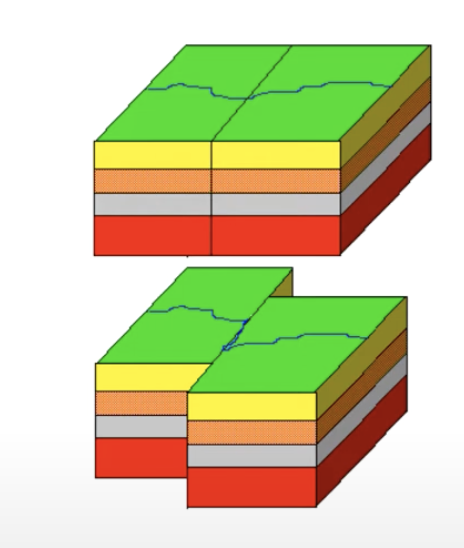
what kind of fault is this
right-lateral strike-slip
stress in a strike-slip fault
acts somewhat differently; the stress applied comes from all directions, but at an angle to the fault itself which results in a strike-slip fault
shear stress
a force acting parallel to a material's surface, causing internal planes to slide past each other; found in strike-slip faults
lateral motion
found in strike-slip faults
vertical motion
found in dip-slip faults
oblique faults
faults with both lateral and vertical motion
where most earthquakes occur in california
right-lateral strike-slip faults
vertical motion in strike-slip faults
does exist—during an earthquake there is differential motion and sudden slip —however it is much fewer than the lateral motion
body waves
the seismic waves that emanate from an area of rupture, they propagate through the body of the earth (hence the name)
why surface waves occur
because the epicenter receives the brunt of the energy of an earthquake due to its location above the focus
surface waves
when the epicenter of an earthquake is lifted up and dropped suddenly, causing undulations to radiate on the surface
types of body waves
p-waves and s-waves
p-wave
primary wave, travels faster than an s-wave but carries less energy
order of wave propagation in an earthquake
p-wave comes first (primary) and s-wave comes second (secondary)
s-wave
secondary wave, travels slower than a p-wave but carries more energy and more shaking
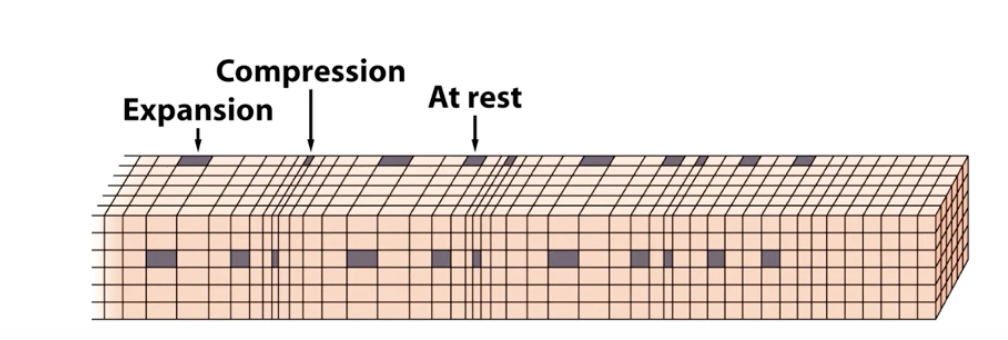
what is this
a p-wave
how p-waves travel
particles of what they travel through are compressed then stretched, like a slinky. energy is transferred by particles bumping into adjacent molecules in the same direction of the wave
compressional waves
alternate name for p-waves due to the fact that their motion is dependent on compression within the direction the wave travels
what surfaces p-waves can travel through
any—solid, liquid, or gas; most notably through the center of the earth

what is this
an s-wave
shear wave
alternate name for s-wave; an elastic body wave where particles move perpendicular to the wave's direction of travel
how do p-waves move
parallel
what can s-waves move through
solids and gases, no liquids; cannot move through molten material in earth
2 types of surface waves
rayleigh wave and love wave
rayleigh wave
what causes swaying, a motion back and forth within the surface of the earth
love wave
retrograde undulations that cause the earth to move ocean-like

what kind of wave is this
rayleigh wave

what kind of wave is this
love wave
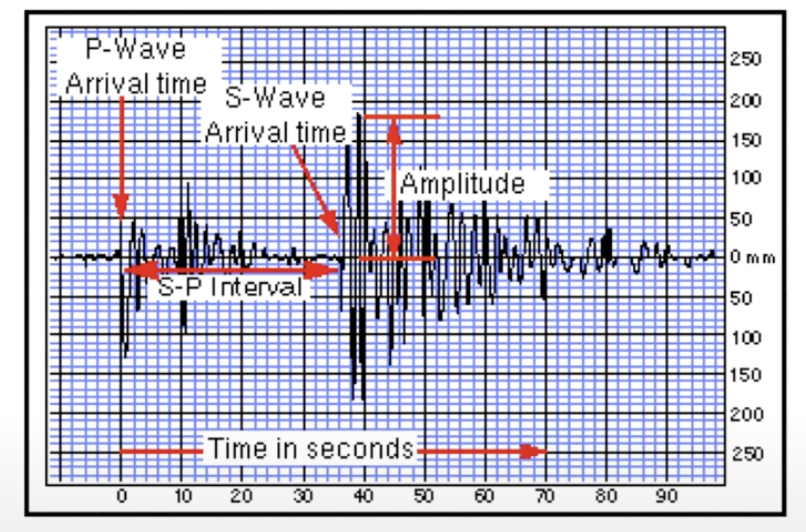
what is this
a seismogram
seismometer
instrument that measures and records details of earthquakes; a triaxial device that allows us to see components of motion found in earthquakes—in 3 directions
what is plotted on a seismogram
ground motion against time
what components of motion a seismogram records
east-west, north-south, and vertical
why are more focal radii better for determining an earthquake’s epicenter
there are small disturbances within measurements, so more makes it more accurate
what is a magnitude about
ground motion in the area of rupture
moment magnitude scale
magnitude scale used by scientists; more accurate for large earthquakes—takes into account factors other than amplitude
richter magnitude scale
what the public uses for magnitude scale; weaker because its accuracy declines as earthquakes get bigger due to its reliance on the amplitude of an earthquake as shown on a seismogram
what factors moment magnitude takes into account
calculates the seismic moment, which is proportional to the fault's area, the amount of slip on the fault, and the rigidity of the rock.
ground motion and energy relationship for magnitude
for each increase in magnitude on ground motion, 10x (logarithmic); for each increase in magnitude on energy, 31.5x
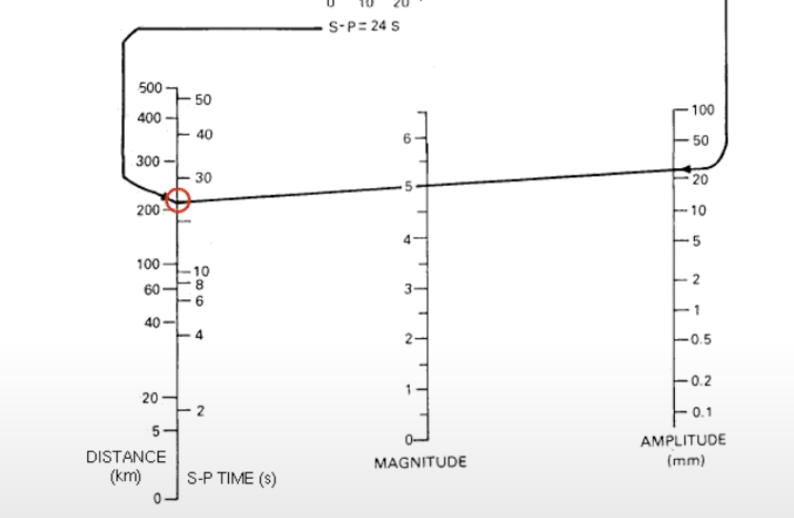
what is this called
a nomogram
nomogram
scale used for calculating richter magnitude; peak amplitude of s wave and s-p time/distance on either side, the middle point on the line is richter magnitude
magnitude
a single number that refers to the GROUND MOTION and energy released at the area of rupture
intensity
what is experienced at a certain area when an earthquake occurs
magnitude vs intensity
there is one magnitude for an earthquake, but intensity can vary for multiple diff. factors
modified mercalli scale
scale which describes the intensity of an earthquake; is observation-based and has 12 levels, using roman numerals and with higher numbers being higher intensity
ground rupture
visible cracking along a fault line that can be due to the main trace of the fault moving (if it ruptures all the way to the earth’s surface)
why does ground rupture occur
in large earthquake events with so much deformation, a number of ruptures occur (some with appreciable motion) in order to accomodate deformation
why is ground rupture not as important
it accounts for less than 1% of earthquake damage, and in california is strictly regulated to make sure structures aren’t built on faults to avoid this
seismic shaking
the cause of most earthquake damage around the world; dependent upon earthquake’s magnitude, distance from epicenter, and amplification of shaking (jello + matthew and lisa)
magnitude in seismic shaking
the larger the quake, the more seismic shaking
distance from epicenter in seismic shaking
the closer to the quake, the more shaking
the jello effect
the principle that less rigid items or surfaces are subject to more seismic shaking
jello effect example
a house of cards is built on both a slab of granite and a jello mold, then hit with a rubber mallet. the house of cards on the jello mold will shake much more and collapse, while the one on the granite slab will remain fine. the jello is non-rigid
jello effect explanation
a seismic wave’s velocity is related to density (almost negligible effect) and rigidity. the more rigid, the faster the waves travel. when a seismic wave passes through a non-rigid object (jello), the waves slow down and are compressed, which increases the amplitude of the wave and thus the shaking AND it makes the wave take more time to travel through the area, giving it more time to shake and inflict damage
where does the jello effect happen IRL
unconsolidated sediment, bayfill, soft mud and slits, surficial deposits (things that gather on the earth’s surface)
matthew and lisa sitting in a swing
the principle that if a seismic wave is at the peak of its amplitude and an object is at its resonance frequency, they line up and create a constructive interference where the seismic wave will resonate (vibrate with increasingly large amplitude)
resonance frequency
the natural frequency at which a system vibrates with maximum amplitude when subjected to a driving force at that same frequency — the object’s peak
constructive interference
the phenomenon where two waves combine to form a new wave with a larger amplitude than the original waves
matthew and lisa & jello effect relationship
non-rigid surfaces/items are more susceptible to the matthew and lisa effect, meaning it can combine with the jello effect and makes non-rigid items even more susceptible to seismic shaking
ground acceleration
a vertical component of the seismic waves coming in; if there is a structure that holds weight (a force), a moment can occur where the ground and structure pulls away, then the item will accelerate down due to gravity, and if the structure accelerates up, the two meet and the force can double which leads to catastrophic collapse